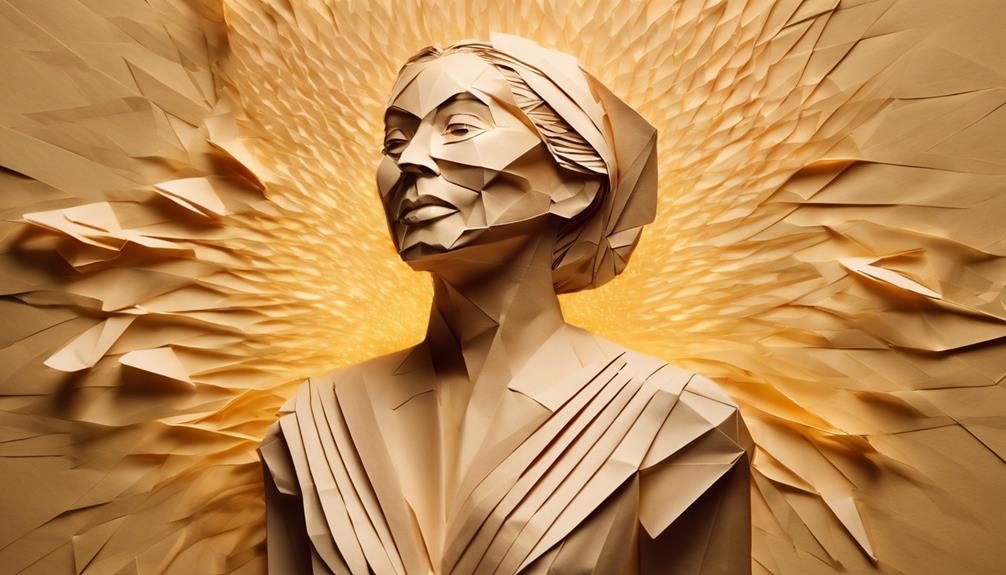You're about to uncover the fascinating hidden gems of the modern-day Olympics, where athletes have bitten into their medals since ancient times to verify their authenticity, and where the iconic five-ring symbol represents the unity of the five continents. From surprising Olympic events like tug of war and ski ballet, to inspirational moments that transcend sports, you'll discover the rich history and culture behind the Games. As you explore the world of Olympic medals, records, and achievements, you'll find yourself drawn into a world of unity, history, and authenticity – and there's still so much more to explore.
Key Takeaways
- The Olympic medals are not made of pure gold, but mostly silver, with the gold medal containing only 1.34% gold.
- Athletes biting their Olympic medals is a tradition that dates back to testing the authenticity of precious metals.
- Ski ballet, a combination of skiing and ballet movements, was a demonstration sport at the 1988 Winter Olympics.
- The Olympic flame is lit from the mother flame in Olympia, Greece, and represents the continuity of the Games and the spirit of competition.
- Live pigeon shooting was once an Olympic event, featured at the 1900 Paris Olympics.
Olympic Traditions and Rituals
As you explore the world of Olympic traditions and rituals, you'll uncover a treasure trove of fascinating facts and symbolism that add depth and meaning to the games. Take, for instance, the Olympic medals, which are mostly made of silver, not pure gold.
You might've noticed athletes biting their Olympic medals – this tradition dates back to the need to test the authenticity of precious metals like gold and silver.
The iconic Olympic rings, comprising five interconnected circles, symbolize the unity of the five continents, with each color representing a different continent.
When you walk into an Olympic stadium, you'll notice winners' names engraved on the Olympic stadium walls, honoring their achievements and marking their place in history.
The Olympic flame, lit in a special ceremony in Greece, represents the continuity of the Olympic Games and the spirit of competition.
These traditions and rituals weave together to create an unforgettable experience, making the Olympics a truly unique event.
Surprising Olympic Events

As you explore the world of Olympic events, you'll stumble upon some surprising and intriguing competitions that'll leave you wondering how they ever became part of the Games.
From peculiar winter sports to discontinued events that'll make you cringe, the Olympic Games have a rich history of unexpected activities.
Let's take a closer look at some of these unusual events that'll leave you amazed and curious.
Tug of War History
You might be surprised to learn that Tug of War, a childhood playground game, was once a serious Olympic sport, with teams of strong-armed athletes competing for gold medals from 1900 to 1920. As an official event in the Summer Olympics, Tug of War required strength, teamwork, and strategy to win the match. The event was contested by both men and women, with various countries participating.
Here's a breakdown of Tug of War's Olympic history:
| Year | Olympic Event |
|---|---|
| 1900 | Introduced as an official Olympic event |
| 1904 | First medals awarded to teams from the United States, Greece, and Great Britain |
| 1908 | Teams from Sweden, Norway, and Denmark join the competition |
| 1912 | Last Olympic games featuring Tug of War as an official event |
| 1920 | Tug of War removed from the Olympic program |
Despite being a popular sport at the time, Tug of War was eventually removed from the Olympic program. Although it's no longer an Olympic event, Tug of War remains a fun and challenging activity that promotes teamwork and strength.
Unusual Winter Sports
Winter Olympics have featured some surprising events over the years, and you might be astonished by the unusual sports that have made their way into the program. You mightn't know that ski ballet, which combined skiing and ballet movements on the slopes, was once an Olympic event. Yes, you read that right – ski ballet!
Here are a few more unusual Winter Olympic sports that might surprise you:
- Ice climbing, where athletes ascend frozen waterfalls using ice axes and crampons, was a demonstration sport at the 2014 Sochi Winter Olympics.
- Skijoring, a sport where a skier is pulled by a horse, dog, or motor vehicle, has been featured in the Winter Olympics as an exhibition sport.
- Snow volleyball, a variation of traditional volleyball played on snow-covered courts, has been proposed as a potential addition to future Winter Games.
These unusual sports show just how diverse and creative the Winter Olympics can be. And who knows, maybe one day we'll see bandy, a team sport similar to ice hockey, make a comeback to the Olympic program.
Discontinued Events Today
From live pigeon shooting to tug of war, the Olympics have featured some astonishing events that have been discontinued over the years. You might be surprised to learn that live pigeon shooting was once an Olympic event, albeit only at the 1900 Paris Olympics. Tug of war, on the other hand, was an official Olympic event from 1900 to 1920.
While these events may seem unusual to us today, they were once a part of the Olympic program.
In contrast, events like dressage, where horses are trained to perform intricate movements, are still part of the Olympic equestrian program. In fact, did you know that dressage horses have their own passports for travel? Another event that's still around is the modern pentathlon, which combines five different sports. Although it's evolved over the years, it's interesting to note that athletes used to shoot at live chickens in the past.
The Olympics have certainly come a long way, and it's fascinating to look back at the events that have been discontinued.
The Evolution of Olympic Medals

As you explore the evolution of Olympic medals, you'll discover a fascinating story of transformation.
You'll learn how the materials used to make medals have changed over time, from the introduction of new metals to the creative designs that reflect the host country's culture.
Medal Material Evolution
As you hold an Olympic medal, you're grasping a piece of history, one that's evolved greatly over the years regarding material composition and design aesthetics.
The evolution of Olympic medals reflects the changing trends in material availability and design aesthetics.
Here are some key facts about the material composition of Olympic medals:
- Gold medals aren't pure gold: They contain silver and bronze in their composition.
- Silver medals are mostly silver: Containing 92.5% silver, these medals are truly a symbol of excellence.
- Bronze medals are copper-based: Made mostly of copper, these medals still shine bright with pride.
The design of Olympic medals is created by artists from the host country, showcasing cultural elements. Even the ribbons on Olympic medals represent the flag colors of the hosting country.
As you hold that medal, you're not just holding a piece of metal; you're holding a piece of history, crafted with care and attention to detail.
Design and Symbolism
You hold an Olympic medal, and with it, a wealth of symbolism and design elements that have evolved over time to represent the unity and excellence of the Olympic Games.
The medals themselves are a reflection of this unity, with gold medals, silver medals, and bronze medals each containing a unique composition – gold medals aren't even pure gold, while silver medals contain 92.5% silver, and bronze medals are mostly copper.
The designs on the medals are crafted by artists from the host country, featuring ribbons that reflect the hosting country's flag colors. The iconic Olympic rings, symbolizing the unity of five continents, are often overlooked but hold significant meaning.
You might've noticed athletes biting their medals – this tradition originated from testing precious metals, as biting leaves marks on lead but not on gold. It's a symbolic gesture, as the medals are finished with gold but aren't entirely made of gold.
As you hold that medal, you're holding a piece of history, unity, and excellence.
Inspirational Olympic Moments

In the spirit of unity and defiance, Olympic athletes have consistently created unforgettable moments that extend far beyond the playing field. These inspirational moments showcase the true essence of the Olympic spirit, highlighting the power of sports to unite and inspire.
Here are a few examples:
- Protests for a cause: In 1968, John Carlos and Tommie Smith made a black power salute during the medal ceremony in Mexico City to protest racial inequality, sparking a global conversation about diversity and inclusion.
- Acts of friendship: Japanese pole vaulters Shuhei Nashida and Sueo Oe fused their silver and bronze medals to create friendship medals at the 1932 Olympics, demonstrating the true meaning of sportsmanship.
- Trailblazing achievements: Debra Thomas became the first African-American to win a medal in figure skating at the 1988 Olympics, paving the way for future generations of athletes from diverse backgrounds.
These moments remind us that the Olympics are about more than just winning medals – they're about the values of unity, respect, and solidarity that bring us together as a global community.
Olympic Records and Achievements

What motivates Olympic athletes to push their limits and achieve greatness? For you, as a fan, it's thrilling to watch them break records and make history. The Olympic Games have witnessed incredible feats, and you're about to discover some of the most astonishing achievements.
Take Usain Bolt, for instance, who holds the record for the fastest 100m sprint in Olympic history at an astonishing 9.63 seconds. Michael Phelps, the swimming sensation, has won an unprecedented 23 gold medals, making him the most decorated Olympian in individual events. Soviet gymnast Larisa Latynina takes the cake with 18 Olympic medals, the most won by a single athlete.
In Winter Olympics, Marit Bjørgen from Norway reigns supreme with 15 medals in cross-country skiing. And let's not forget Al Oerter, who dominated the discus event, winning four consecutive gold medals from 1956 to 1968. These incredible athletes inspire you to challenge your own limits and aim for greatness.
The Olympic Games' Global Reach

From Athens to Beijing, the Olympic Games have transcended geographical boundaries, fostering a sense of global unity and celebrating the world's rich cultural diversity. As you explore the Olympic Games' global reach, you'll discover that the Games have been hosted by 23 different countries since the modern era began in 1896.
Here are a few interesting facts that paint a picture of the Olympics' global impact:
- The Olympic torch relay has traveled worldwide, including routes that involved underwater passages and even space travel.
- In the 2016 Rio Olympics, a record-breaking 10,500 athletes from 205 countries participated in the Summer Games.
- The Olympic symbol of five rings represents the unity of the five continents, showcasing the global reach of the Games.
You'll be amazed by the Olympic Games' ability to bring people together, regardless of their cultural backgrounds or geographical locations. The Olympic Games have truly become a symbol of global unity, celebrating human achievement and promoting peace and understanding among nations.
The Symbolism of Olympic Icons
As you gaze upon the iconic Olympic symbols, have you ever wondered what stories they tell? The Olympic rings, for instance, symbolize the unity of the five continents, with each color representing a different continent. This powerful symbol of global unity is a beacon of hope, reminding us that, despite our differences, we can come together in the spirit of friendship and competition.
The Olympic flame, lit from the mother flame in Olympia, Greece, represents the continuity of the Games, a tradition that has been passed down through the ages. The flame serves as a reminder of the Games' rich history and the importance of preserving its authenticity.
Speaking of authenticity, did you know that the tradition of biting Olympic medals dates back to testing precious metals? It's a quirky tradition that verifies the medal's authenticity, ensuring that winners receive the recognition they deserve.
Olympic Firsts and Milestones

Beyond the iconic symbols, the Olympics have witnessed numerous groundbreaking moments that have reshaped the course of history, and you're about to discover some of the most remarkable ones.
From trailblazing athletes to innovative events, the Olympics have been a platform for firsts and milestones that have left a lasting impact. Here are a few notable examples:
- 1900 Paris Olympics: The first female athletes made their debut, marking a significant milestone in Olympic history.
- 1968 Mexico City Olympics: The black power protest by athletes John Carlos and Tommie Smith brought attention to social and political issues.
- 2000 Sydney Olympics: Synchronized diving made its Olympic debut, showcasing innovation in Olympic competition.
These milestones haven't only changed the face of the Olympics but have also paved the way for greater inclusivity and diversity in sports.
As you continue to explore the fascinating world of the Olympics, remember that these groundbreaking moments have played a significant role in shaping the Games into what they're today.
Unconventional Olympic Facts

You might think you know the Olympics, but some of its events and rules are downright bizarre, and it's time to uncover some of the most surprising facts about the Games. The ancient Olympics were vastly different from the modern Games, and some of these unusual facts will leave you wondering what the Olympic Committee was thinking.
| Unconventional Olympic Facts | When |
|---|---|
| Live pigeon shooting as an event | 1900 Paris Olympics |
| Tug of war as an official Olympic event | 1900-1920 |
| Dressage horses have their own passports | Ongoing |
But that's not all – did you know that athletes in the modern pentathlon used to shoot at live chickens? Luckily, this practice has been replaced with targets. Even more surprising is the strict dietary regulations in place for athletes, like the 2012 London Olympics, where only water, isotonic drinks, and carbohydrate drinks were allowed. The Winter Olympic Games, equestrian events, and unique team competitions all have their own set of rules and regulations that might raise an eyebrow or two.
Frequently Asked Questions
What Are 5 Interesting Facts About Modern Olympics?
You're curious about the modern Olympics! Here are 5 interesting facts: women first competed in 1900, the Winter Olympics debuted in 1924, the Paralympics started in 1960, Olympic rings symbolize unity, and the Olympics were revived in 1896 after a 1,500-year hiatus.
What Are 5 Interesting Facts About the Ancient Olympics?
You're curious about the ancient Olympics, right? Well, you'll be fascinated to know that ancient Olympians competed naked, had to swear an oath to Zeus, and had their events judged by Hellanodikai, who were actually priests!
Did You Know Facts About the Olympics?
You're curious about surprising Olympic facts, and rightly so! From the modern Olympics' revival in 1896 to the introduction of the Winter Olympics in 1924, you'll uncover fascinating stories and symbols behind the games.
What Is the History of Modern Olympics?
You explore the history of modern Olympics, tracing its roots back to 1896 in Athens, Greece, where it was revived after a 1,500-year hiatus, featuring 14 nations and 241 athletes in 43 events.
What are some little known facts about the modern day Olympics?
The modern olympic game facts include the little-known detail that the first gold medals awarded at the 1904 Olympics were actually made of solid gold. Additionally, the 1900 Olympics in Paris featured some unusual events like firefighting, kite flying, and pigeon racing, which are no longer part of the games.
Conclusion
As you've explored the fascinating world of the modern-day Olympics, you've uncovered a treasure trove of surprising facts and inspiring stories.
Like a perfectly choreographed relay, the threads of tradition, innovation, and human achievement have woven together to create a rich tapestry of Olympic excellence.
As you look back on these remarkable discoveries, remember that the Olympics are more than just a competition – they're a celebration of human spirit, perseverance, and the unbreakable bonds that unite us all.










